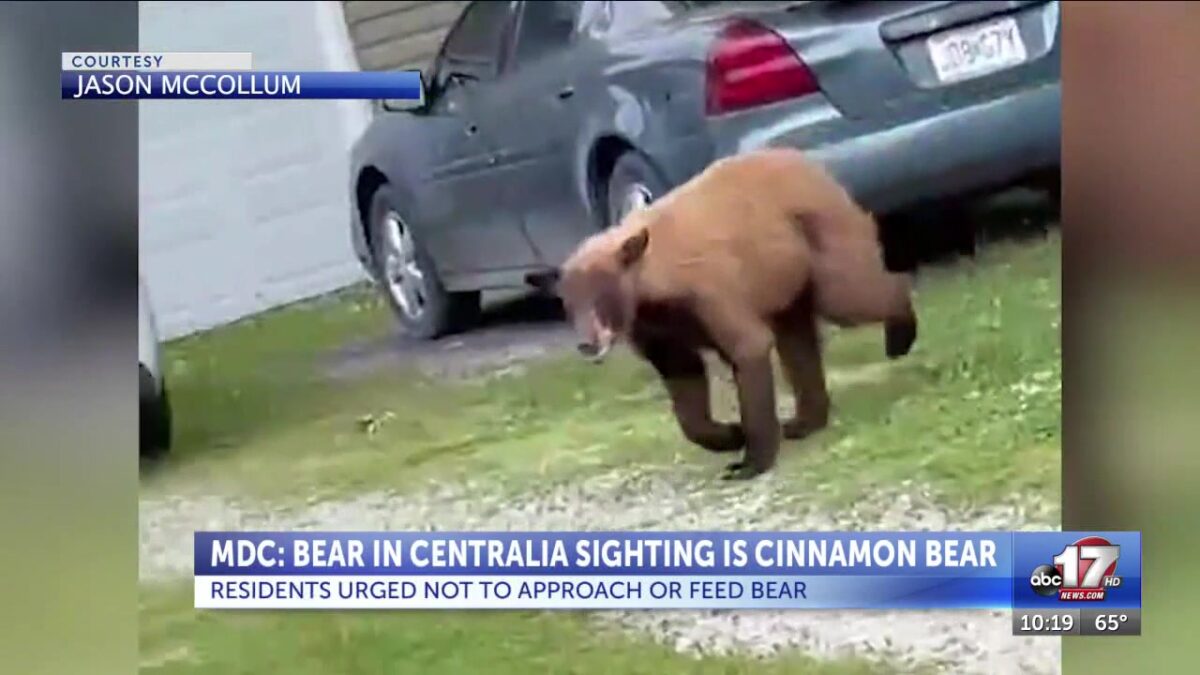Department of Conservation says bear in Centralia sighting is cinnamon bear

Haley Swaino
CENTRALIA, Mo. (KMIZ)
The bear spotted in Centralia on Saturday was a cinnamon black bear, according to Missouri Department of Conservation biologist Nate Bowersock. Cinnamon bears are a subspecies of the American black bear.
Centralia residents were warned on Saturday to be on high alert in a social media post from police after a “brown bear” sighting in the city.
Multiple people have seen the bear and shared videos with ABC 17 News.
A cinnamon bear is seen Saturday in Centralia. Courtesy of Jason McCollum
Bowersock said he has seen many of the bear sighting videos going around and confirmed it is not a brown bear.
“That bear is what we call a cinnamon black bear or a black bear that has a reddish brown coat color,” Bowersock said. “It is a black bear and not a brown bear, which would then suggest a grizzly bear, which is whole different species, which we do not have here in Missouri.”
He said black bears can range in color from blonde to black.
According to the Missouri Department of Conservation, the Show-Me State is home to roughly 1,000 black bears.
Courtesy of Emilee Lawson (Centralia)
Bowersock said the MDC received reports of a similar-looking bear in nearby Callaway County.
“It’s potentially moved up there to the Centralia area,” Bowersock said. “And we haven’t gotten any reports on it now since I think late Saturday so it might have moved on.”
MDC has seen more young bears out earlier this year.
“We’re seeing a lot of younger bears,” Bowersock said. “That bear (in the video) also looks like a young bear dispersing from its native range. So just (it is) trying to find a new place to set up shop and and live its own life.”
If someone encounters a bear, Bowersock said the best way to stay safe is to steer clear of it.
“Black bears are more scared of us than we are of them, which can be hard to think about because people have a lot of thoughts about bears in general, whether it’s a black bear or grizzly bear,” Bowersock said. “But the big thing is giving them their space.”
He said, like any wild animal, these bears are wild.
“They are just trying to look for food at the end of the day, and especially for a black bear, their whole lives revolve around food,” Bowersock said. “They wake up out of hibernation in the spring and they’re looking for food and trying to just pack weight on.”
Centralia police advised residents to not approach, attempt to pet or feed the bear. MDC encourages the same.
“We always encourage people to never feed wildlife and for bears especially, they can become what we call habituated,” Bowersock said. “They can start to lose that fear of humans if they start to get that free food.”
Since finding food is typically a bear’s top priority this time of year, he said they will often look anywhere for food sources that could meet their needs.
Bowersock said taking down bird feeders and other sources of food can help keep curious bears away as they bulk up before retreating to hibernation later in the year.
“If you think about it, a bird feeder can be enough calories for a bear for an entire day of searching the woods on its own,” Bowersock said. “That’s a lot less energy for them to expend to go bird feeder to bird feeder than scouring the woods for food.”
Bowersock said no injuries have happened as a direct result of bears being fed in Missouri, but that has happened in other states. Cleaning or bringing outside grills and smokers inside is another precaution to take if a bear has been spotted in the area. He also recommends not leaving garbage out.
“Especially since that time of year, we all like to be grilling and smoking,” Bowersock said. “That can be very enticing to a bear.”
Bowersock said in the grand scheme of things, bears do not pose a deadly threat.
“If you do hear of bear activity in the area, you don’t need to be freaking out by any means, but you should try to pull in those attractants,” he said.
As the bear population in Missouri is growing, Bowersock said it’s important to remain vigilant.
“We estimate about a 9% growth rate, which means we expect the population to double in size every 10 years,” Bowersock said. “Right now we estimate a little over a thousand Bears statewide.”
MDC receives regular bear reports out of Mid-Missouri. Bowersock estimated 1,015 confirmed bear reports in central Missouri this year, mainly south of the Missouri River.
He said the Ozark region is where the department sees the most bears.
“We’ve had more active sightings earlier in the year so far this year,” Bowersock said. “I think part of that might just be the fact that we are seeing that increase in the bear population and they are really starting to explore new areas, which includes north of the river and central Missouri.”
According to a social media post from the Centralia Police Department, animal control and conservation officials have been made aware of the bear and are monitoring the situation. Anyone who notices the bear should immediately call law enforcement at 311.
People can also report a bear to MDC on its website.